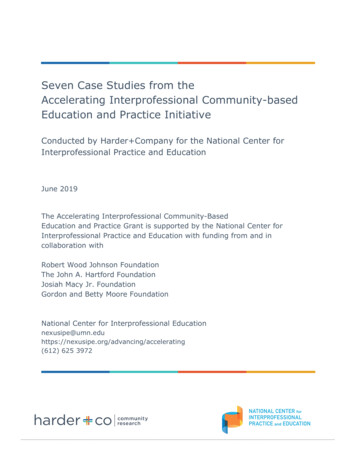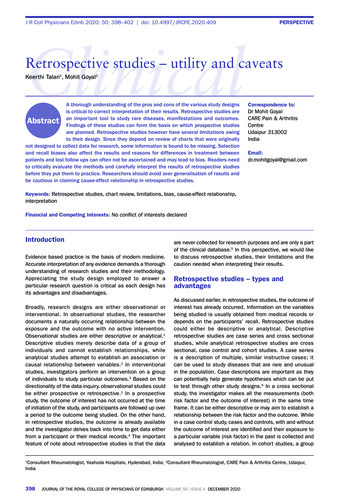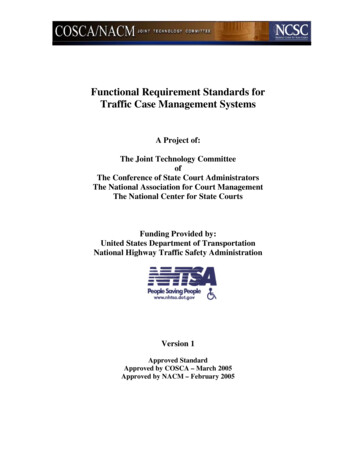
Transcription
Seven Case Studies from theAccelerating Interprofessional Community-basedEducation and Practice InitiativeConducted by Harder Company for the National Center forInterprofessional Practice and EducationJune 2019The Accelerating Interprofessional Community-BasedEducation and Practice Grant is supported by the National Center forInterprofessional Practice and Education with funding from and incollaboration withRobert Wood Johnson FoundationThe John A. Hartford FoundationJosiah Macy Jr. FoundationGordon and Betty Moore FoundationNational Center for Interprofessional ncing/accelerating(612) 625 3972
Authorship:Case studies were authored by Harder Company Community Research Team. Each case study was reviewed bythe National Center Accelerating Initiative team including an additional external evaluator based on documentreview and site visits. Each Nexus Team reviewed their case for accuracy of content and context.Citation for Seven Case Studies from the Accelerating Interprofessional Community-based Educationand Practice Initiative:Harder Company Community Research. (August 2019). Seven Case Studies from the AcceleratingInterprofessional Community-based Education and Practice Initiative. National Center for Interprofessional Practiceand Education, Minneapolis, Minnesota. 2019 Regents of the University of Minnesota. All rights reserved.AcknowledgementsThese case studies are part of a national, two-year IPE implementation study conducted between November 2016and December 2018. Harder Company conducted the interviews and per interview protocol, no individual isidentified in the case study allowing for an open conversation regarding each interviewee’s assessment of theteam’s work.The National Center for Interprofessional Practice and Education and Harder Company Community Researchacknowledges each Nexus Team and organizational leaders for their commitment in documenting their Nexusstories. Accelerating Initiative sites are listed in the order they appear in this document.1.University of Nebraska Medical Center, Omaha, NebraskaCommunity Partners: Ambassador Health, Omaha, Skilled Nursing and Rehabilitation; Azria Health MidtownProgram Title: Comprehensive Geriatric Assessment Practice and Interprofessional EducationCase Study Title: Nexus Success in Nebraska: Invested Leaders and True Partnerships2.Washburn University, Topeka, KansasCommunity Partner: Topeka Housing AuthorityProgram Title: Classroom to Community: Implementing Patient-Centered Care in Public Housing ProgramCase Study Title: Improving Health Access for Public Housing Residents: Washburn’s Nexus Team3.University of Utah, Salt Lake City, UtahCommunity Partner: Housing Authority of the County of Salt Lake (now Housing Connect)Program Title: Interprofessional Collaborative Systems-based Practice: Addressing the Drivers of Healthand Health Care Utilization for Chronically Homeless Individuals in a Housing First ModelCase Study Title: Putting Interprofessional Education into Practice: The University of Utah Serves theCommunity through Hotspotting4.University of Pittsburgh, Pittsburgh, PennsylvaniaCommunity Partner: UPMC Staying at Home program; Associates in Family Health CareProgram Title: Interprofessional Education Exchange Program (iPEEP)Case Study Title: Promoting Independent Living and Quality of Life for Older Adults: University ofPittsburgh’s Nexus Team5.Arizona State University, Tempe, ArizonaCommunity Partner: Crossroads, Inc.Program Title: Interprofessional by Design: Meeting at the Crossroads to Accelerate LeadershipCompetency and Readiness for Transition to Interprofessional PracticeCase Study Title: Expanding a Successful Interprofessional Approach with a Strong Community Partner:Arizona’s Nexus Team6.Creighton University, Omaha, NebraskaCommunity Partner: Catholic Health Initiatives (now CHI Health); Creighton University Medical CenterProgram Title: Cultivating Collaboration: Building a Successful Collaborative Care Model in an AcademicHealth PartnershipCase Study Title: Matching High-Utilization Patients with Personal Care Teams: Creighton University’sInterprofessional Nexus7.University of Hawaii at Manoa, Honolulu, Hawai’iCommunity Partner: Hawaii Department of Education Keiki Program; Sanford Dole Middle SchoolProgram Title: Hawai i Interprofessional Education and Collaborative (HIPEC) AllianceCase Study Title: Providing Health Care in a School Setting: University of Hawaii’s Nexus Team
Current Realities. Health care is changing, and health professions educationneeds to change with it. Even with nursing education starting to move moreinto the community, clinical nursing education still takes place primarily inacute care settings with nursing preceptors. Although other health professionalstudents may be learning in the same site, often in acute care settings, theyrarely interact, let alone learn how to work together as a team. Over the pastdecade, clinical care has rapidly evolved to become more team-based acrossprofessions and increasingly practiced in the community. To provide highquality, safe, coordinated, person-centered care in the 21st century, all healthprofessionals must be better prepared to lead and work in interprofessionalteams in community settings.The Accelerating Initiative. In 2016, four foundations - the Robert WoodJohnson Foundation, the Josiah Macy Jr. Foundation, the Gordon and BettyMoore Foundation, and The John A. Hartford Foundation – partnered to changetoday’s realities by stimulating new thinking about how teams of students andhealth professionals can actively learn and work together with people toimprove health and wellbeing in the community. Their vision matched theexperience of the National Center for Interprofessional Practice and Education(National Center) in implementing academic-practice partnerships, called the“Nexus”, “redesigning both healthcare education and healthcare deliverysimultaneously to be better integrated and more interprofessional whiledemonstrating outcomes”. Together, they created the AcceleratingInterprofessional Community-Based Education and Practice Initiative(Accelerating Initiative) to advance graduate-prepared nurses to leadacademic-practice teams to demonstrate they make a difference in the healthand wellbeing of the people and communities they serve. The AcceleratingInitiative was achieved through a national call for proposals in 2016 with 16graduate nursing schools selected to redesign how interprofessional teams,including students and residents, can add value in their communities byimpacting the lives of their citizens. All 16 sites worked with a communitypartner serving vulnerable populations. The National Center’s approach toimplementing the Accelerating Initiative was to provide extensive technicalassistance to the developing Nexus teams which is detailed in the Harder Company Community Research final report.The Nexus, “redesigning bothhealthcare education andhealthcare deliverysimultaneously to be betterintegrated and moreinterprofessional whiledemonstrating outcomes”.Case Study Site Selection and Process.As part of an external evaluation conducted by Harder Company, seven out of 16 sites were chosen based onCase Study Sites with Primary Focusgeographic distribution, program* focus, significant earlyUniversity of Nebraska Medical Center (Geriatric)progress in forming a Nexus Team and implementing aWashburn University (Geriatric)Nexus program, and evidence of acceleration in showingUniversity of Utah (Mental Health/Substance Abuse)outcomes. The seven case studies are the result ofUniversity of Pittsburgh (Geriatric)separate, semi-structured interviews with each principalArizona State University (Mental Health/Substance Abuse)investigator and 8-10 key members of each Nexus team.Creighton University (Primary Care/New Models)Interviews were conducted between February andUniversity of Hawaii at Manoa (Primary Care/New Models)December of 2018, are reported in chronological order byinterview date, and include updated outcomes reportedby the grantees in June 2019.Thematic analysis is included in Harder Company’s final report.Acknowledgement: The National Center acknowledges the 7 Nexus Teams andtheir commitment in documenting their Nexus stories.* The National Center purposely uses the term program to describe the workof these teams instead of the ‘one and done’ project which puts people in themindset that once the grant goes away, so does their project.
Nexus Success in Nebraska:Invested Leaders and TruePartnershipsA Case Study for the AcceleratingInterprofessional Communitybased Education and PracticeInitiativeJune 2018
About This Nexus ProgramAcademic PartnersThe University of Nebraska Medical Center College of Nursing designed itsNexus program to address the health risks that patients face when theytransition from a hospital to a skilled nursing facility. This patient population,largely comprised of older adults, receives acute care in the hospital, followedby nursing care in a skilled nursing facility (SNF) with the aim of recoveringenough to return home safely. But with typically minimal communicationbetween the hospital and the SNF, and patients arriving with an often widearray of medications prescribed by multiple providers, re-hospitalizations arefrequent. Without comprehensive patient assessment and management of themedications, improper doses and interactions between medications can lead toserious adverse health effects. University of Nebraska MedicalCenter College of Nursing University of Nebraska MedicalCenter College of PharmacyCommunity Partners Two skilled nursing facilitiesThe Nexus program aims to develop a team-based approach across providersand professions to improve patient safety. Specifically, the program trainsAdult Gerontology Nurse Practitioner students and Doctor of Pharmacystudents together in classroom and clinical settings. The students learn abouteach other’s’ roles and engage in team practice along with staff at SNFs.Student and staff participants actively take part in interprofessionalassessments to keep clients safe and see firsthand the value of knowledge andresponsibilities that each team member contributes. Program leaderssummarized the primary goals of the Nexus program as the following:1.To improve student understandings of the risks to SNF clients and howinterprofessional, patient-centered practice can lower those risks.2.To improve health outcomes for SNF clients, reducing medicationrelated adverse events and re-hospitalizations.One partner described the program as addressing an important, longstandingneed. “It’s my passion that we can make the skilled nursing units safe, reducereadmissions, medication errors, and the associated costs,” she stated. “It’sbeen overlooked far too long.” Another noted that over time, healthcareproviders have experienced increasing pressure to be efficient, leading to lesstime spent with each patient. As a result, she said, “when we talk aboutpatient-centered care and patient safety, being intentional is more necessary”today than it ever has been.Implementation ExperiencesThe ongoing implementation of the University of Nebraska’s Nexus programprovides insights into factors that have contributed to its success to date.An existing culture of teamwork and comfort with interprofessionalapproaches helps the Nexus team thrive.Partners on the Nexus team emphasized an existing culture ofinterprofessional education at the University of Nebraska Medical Center thatfacilitated administrators’ enthusiastic buy-in on the program and contributedto the success of the collaboration. One program leader described anincreasing receptiveness to interprofessional approaches as a broader culturalshift at the university. “Our campus, our organization, is so focused oninterprofessional education,” she explained. “I'm not all by myself making aculture change There's a lot going on at our campus.” Indeed, the Nexusprogram fit seamlessly into the University of Nebraska’s interprofessionalinterests. An administrator described it as ideal, saying, “This grant fit in“It’s my passion that wecan make the skillednursing units safe, reducereadmissions, medicationerrors, and the associatedcosts. It’s been overlookedfar too long.”
perfectly with the university’s mission and vision. Long term care provided aperfect opportunity for interprofessional learning and practice It’s set anexample that will serve us well in the future. This is the model that I’ve beensearching for.”The culture of collaboration showed in the Nexus program’s implementation. Ateam member from the College of Nursing noted a strong relationship with theCollege of Pharmacy. “We’re working collaboratively [on developingcurriculum],” she said. “Their support has been invaluable.” Moreover, thebridge between academic gerontology and an older adult population in thecommunity was a natural fit. “Geriatrics has always been a team sport,”remarked a community partner. An academic partner echoed, “Geriatrics is ateam business. We just feel that’s the only way you can really be safe.”Each partner’s leaders are invested in the program.For the University of Nebraska Medical Center and the skilled nursing facilities,participating in a Nexus program is a serious investment. Academic partnershad to identify funding sources; enable faculty to devote time to the planning,management, and implementation; and ensure student participation inclassroom and community practice components. Community-based SNFs hadto provide matching funds and allow staff to take substantial time to engagewith students on site and implement new team-based work practices.Investments like these require strong leadership buy-in, something this Nexusprogram fully secured. “The biggest success,” one team member commented,”is the amount of support we’ve received across the board. The communitypartners are very eager. Their support of having students there and workingwith their staff has been marvelous. College deans and even the chancellor ofthe university are very positive and want us to do more integrative andinterprofessional education across the colleges. Everybody’s been very helpfulin getting this off the ground.” An academic leader, also noting widespreadsupport among university administrators, specified that the program wascompelling because it was “helping to amplify our commitment tointerprofessional education and moving it into the clinical environment Ouruniversity is dedicated to this.”The community partners, too, proved strongly committed. When universityfaculty first reached out to a SNF as a potential community partner, they wereunsure how difficult it would be to come up with the required fiscal match. Butas one shared, “The most amazing thing happened: they actually volunteeredto provide the match. It told us we were really onto something” that resonatedwith the SNF. Other team members added that executive support at thenursing facilities has continued. “They walk the talk. [They] gave the money,”noted one. “And more than that, they've also allowed the staff time to sit andwork with the learners and help educate the learners. [It’s] a pretty amazinglevel of support.” At the skilled nursing facilities, remarked another, “There’sjust tremendous passion and energy and a commitment to finding ways toimprove on what we’re doing.”All Nexus participants both give and gain.Everyone who plays a contributing role in this Nexus program benefits. TheUniversity of Nebraska Medical Center moves closer to its vision ofinterprofessional education that translates to interprofessional clinical practice.The skilled nursing facilities develop new collaborative practices that canimprove both staff and client experience. Students reap valuable preparation“The biggest success isthe amount of supportwe’ve received across theboard. Everybody’s beenvery helpful in gettingthis off the ground.”
to apply interprofessional approaches that visibly improve effectiveness. Asone team member put it, “Being open to what the facilities need, what thestudents need, and what the patients need, and looking for the opportunitieswhere everybody can win through the same intervention—that's a prettystrong win.” Exhibit 1 summarizes some of the contributions by and benefits todifferent types of participants on the program.Exhibit 1.Selected Responsibilities of and Benefits to Nexus ParticipantsParticipantsFaculty from Collegesof Nursing & PharmacySkilled Nursing Facility(SNF) staffNurse Practitioner andDoctor of PharmacystudentsResponsibilitiesBenefits Collaborate on curriculumdevelopment Arrange for students to participate indidactic and clinical training Coordinate with community partners Strengthened interprofessional culture atuniversity Students better prepared as effectivepractitioners Positive influence on SNF clients’ health outcomes Coordinate with academic partners Train and work with visiting students Participate in daily team huddles Improved collaborative experience on the job Positive influence on SNF clients’ health outcomes Prepare for and actively participate inclassroom and clinical training Improved understanding of roles and expertise onan interprofessional team Improved understanding of clinical realities atskilled nursing facilities Experience contributing to interprofessionalproblem-solving. Positive influence on SNF clients’ health outcomesA strong ethos of equal partnership sets the stage for participants to activelytake on responsibilities. A community partner described how leaders on theteam demonstrate interprofessional decision-making, striking a contrast withmore hierarchical decision-making that clinicians experience in hospitalsettings:[The students] haven't seen a pharmacist and a nursepractitioner get in depth talking about this med versus thatmed and clinical correlations. It was wonderful for them to see[those] interactions. In the hospital it's pretty much one way:[decision-making] all trickles down. Not out here in thecommunity. In the community it's a level playing field.Everybody has to do their part to make things better for thepatients.“These skilled nursingfacilities have tremendousturnover, but that’s thevery real world AnythingThrough examples like this, students come to see that they have valuableexpertise to contribute and so do the other professionals.we do has to beThe mindset of mutual contribution informs the interprofessional studentinteractions and practice experiences. One partner attributed collaborativesuccess in part to leaders setting clear expectations for students. “[Theprincipal investigator] expects the learners to do their homework ahead oftime, come with a good attitude, and participate,” she said. “In my experienceteaching residents without those expectations, they're passive. That's notNexus. [This] program is very interactive: you participate and patients dowell.” Another partner, relating “a good Nexus moment,” commented thatstudents’ equal voices gives them a sense of accountability. “Everyone hadtheir say. There was no one left out and they were writing the care plantogether,” she recalled. “One of the students said to me, ‘Well, we're signingcontext of some prettyimplementable in thesignificant turmoil becausethe turmoil doesn’t goaway.”
our names on this, aren't we?’” The partner explained that in typical settings,a care plan would be signed only by the senior provider. In this instance,recognition of the full team’s contributions served to imbue members with astronger sense of responsibility. Overall, the experiences and opportunitieshave led to what a team member termed “strong student interest” in theprogram.Turnover among faculty and SNF staff is a challenging reality.Changes in who is involved in implementing a Nexus program is inevitableover time; a program’s resilience in the face of personnel turnover is crucial toits longevity. Skilled nursing facilities are known to have high staff turnover,and program members saw this as an important reality to work with. “Theseskilled nursing facilities have tremendous turnover, but that’s the very realworld,” remarked one. “We’re recognizing that anything we do has to beimplementable in the context of some pretty significant turmoil because theturmoil doesn’t go away.”One way that the program has handled changes among the faculty andcollaborative partners has been to build in a strong training component tobring newcomers up to speed. “We retrain and in some cases start over,”explained a partner, continuing,We’ve adapted well, but overall that is a big need for anypartnership We’ve done such a great job of training peoplethat in many cases, people in outside agencies have hiredthem away from us! It’s a success but also a negative becausewe’d like a stable core team. The nursing facilities have atremendous turnover. To develop and create that transparentteam where we’re able to do each other’s role is hard with anunstable team. We’re still doing it, but that’s one of ourbiggest hurdles.Notably, one of the community partner organizations has anecdotally noticed adecrease in staff turnover during the last few months, a change they attributeto the rewarding nature of the program’s team-based approach. A staffmember there explained that “a big albatross in long term care [is] turnoverrates greater than fifty percent for certified nurse assistants. It’s an industryproblem.” But, she continued, she observes through the Nexus program “howteam building decreases staff turnover. [The collaboration] has this nice rippleeffect that was not one of the intentions, but I see it. I’d like to [collect]some statistics.”On the academic side, the need remains for the University of Nebraska tostrategize about supporting a more stable team for the future. One teammember pointed out that the staff time needed to manage and implement aprogram of this complexity requires a substantial investment, something shehopes administrators and potential funders recognize. “The hardest part ismanaging a relatively big program with a relatively small budget,” shecommented. “There are a number of us who have donated our time to thisstudy, and have done so happily, but can’t do so long term. [It’s a matter of]balancing that passion about what we’re doing and the understanding of howmuch value is here with the reality that you don’t get tenure or promotionwhen you’re donating your time.”“This is pretty outstandingstuff, not sending peopleback to the ER or hospital.”
Emerging ResultsWith the University of Nebraska’s program less than two years into itsimplementation, outcomes among students and older adults have not beenfully measured. But preliminary observations by Nexus team members showpromising signs of change.Exhibit 2.Emerging Results from the Nebraska Nexus ProgramType of ResultStudent changesSNF changeHealth changePreliminary ChangeDescription Improved interprofessionalunderstanding Seeing healthy, in-depth collaboration between a pharmacistand nurse practitioner “was an eye-opener” for students,according to a community partner. Integrated team approach At one facility so far, daily “huddles,” in which staff cometogether for patient-centered team problem solving, havebecome a durable routine that is fully integrated into the job. Fewer hospital readmissions A community partner noted a substantial decrease inreadmission rates during the program, remarking, “This ispretty outstanding stuff, not sending people back to the ER orhospital.”SustainabilityThe aim of the Accelerating Interprofessional Community-based Education andPractice Initiative is not only to spark innovative programs, but to generate ashift in practice and culture toward interprofessional approaches. Two mainfindings from the University of Nebraska Medical Center College of Nursing andits partners speak to its challenges and strengths regarding sustainability.Success currently relies heavily on the principal investigator’sleadership.The principal investigator’s vision, experience, connections, and leadershipstyle are widely seen as key drivers of this program. Echoing others, one teammember quipped, “We need to clone [her]!” While she has been a tremendousasset, however, the program’s future will be more stable over the long term ifit does not depend so heavily on a single person, but broadens in terms of asense of ownership and leading roles. “There's a big need for more training,building the program, and increasing the personnel that can do this,”cautioned one. Another concurred, noting that in addition to overall leadership,the current program requires substantial involvement by faculty leaders andSNF core staff. Any expansion of the effort would need additional dedicatedand capable experts to manage the intervention. “We need more experts ingerontology to support this model,” she said. “And the same with thepharmacy practitioners.”Early long-term thinking has evolved into more concrete interest insustainability among partners.Sustainability has not been an afterthought, but part of the initial planning andongoing discussions. A key administrator framed the program as helping tomeet the Medical Center’s “goal of moving our interprofessional activities to amore sophisticated and more sustainable long range approach while we'redoing something important in the community,” suggesting strong interest insupporting the effort beyond the National Center’s award. And while University
of Nebraska leaders have long voiced their support of the effort, a site visit bythe National Center for Interprofessional Education and Practice furthercemented the idea of sustaining the program. “They woke up all the bigwigson my campus,” described one team member. “[The National Center] said,‘We want to see this continue to be sustained in your program and to expand,into all of the other colleges.’ That made a huge difference here.”Across the board, team members agreed that leadership at both the universityand at the community partners have become more specific in talking abouthow they will sustain the interprofessional program. One of the SNFs is happyenough with how the program is going so far that they are discussing thepossibility of paying for the principal investigator’s time to keep it going. Otherpartners spoke of recent meetings to discuss financial resources needed,faculty time allocation, and contracts for ongoing work with communitypartners. Confirming the understandings of many team members, a universityadministrator shared being “completely comfortable” that the program willcontinue. Speaking of it as integral to the future of the Medical Center, shecommented that the program builds a model that “puts substance into ourvision that interprofessional education and practice are crucial.”What Nebraska Teaches UsSpecific lessons from the University of Nebraska Medical Center’s Nexusprogram can positively influence similar interprofessional efforts elsewhere.Treat partners as equalsAs this program shows, an interprofessional approach can earn broad buy-inwhen it values the expertise of every partner and participant. Here, all playerswork toward a common goal of improved health and safety of SNF clients, andeach feels accountable for making a meaningful contribution to that goalbecause they bring needed knowledge and experience to the team. The modelprovides a fresh solution in a healthcare environment that is gradually movingaway from what one partner termed the “physician patriarchy” where “it’s allabout a doctor [and] a ‘team’ would be you doing something for him on hisplanet.” In the transitional care setting, in which many staff and providersfrom both a hospital and nursing facility influence a client’s treatment, a Nexusteam approach is of paramount importance, giving all members of a multidisciplinary team a voice and responsibility to ensure client safety.Secure commitments from leadershipInterprofessional collaboration can promise improved outcomes, but it requirestime and resources. To ensure that all partners can fully take part in a smoothprocess, leadership from each partner organization must be willing to invest.One team member described that for this Nexus program, leaders had toshare an understanding that team problem solving was the right path, not theeasiest path. “It takes time to do the right thing and talk to people,” shestated. “It’s easier to send them to the ER, but the patient suffers.” Further, ifleadership buy-in varies across partners, the team approach will beundermined as implementation steps are missed or essential perspectives areabsent from the multi-disciplinary whole. In this program, leaders fromacademic departments and community organizations agreed to share financialburden and allow staff to shift time from usual duties to interprofessionaltrainings and teamwork. Across the board, they saw that without supportingimplementation, they wouldn’t see the results they desired.
Identify clear lines of responsibilityA risk of partnering on a collaborative effort is that some responsibilities mayfall through the cracks if each partner assumes or hopes that someone elsewill take it on. This Nexus program has succeeded in keeping all partners clearon their roles and responsibilities. Not only do the different professionals bringtheir unique expertise—the nurse practitioner students’ in gerontology, thepharmacy students’ in medication, and the SNF staff members’ in client andstaff needs in the SNF setting—but they share an understanding of who will fillroles of management, teaching and training, participation, and financing,among other duties. Highlighting the importance of clear roles, a SNF partnercommented, “The learners know what their role is when they come in. Thenursing staff here know what their role is. Having the accountability andeveryone having their job role helps. When you have unspecified roles it's a lotof, ‘Well who's going to do this? Who's going to t
Community Partner: UPMC Staying at Home program; Associates in Family Health Care Program Title: Interprofessional Education Exchange Program (iPEEP) . graduate nursing schools selected to redesign how interprofessional teams, including students and residents, can add value in their communities by impacting the lives of their citizens. All 16 .











